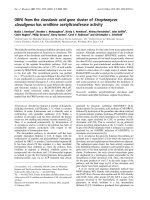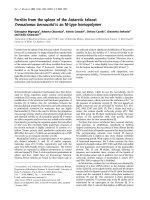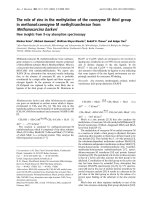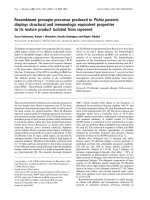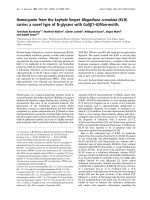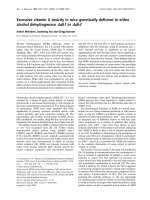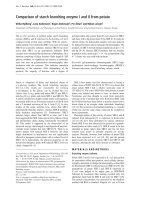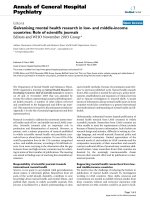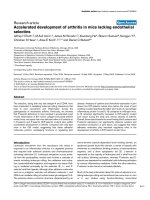Báo cáo y học: "Escape from X inactivation in mice and humans" potx
Bạn đang xem bản rút gọn của tài liệu. Xem và tải ngay bản đầy đủ của tài liệu tại đây (436.71 KB, 7 trang )
e difference in sex-chromosome make-up between
mammalian males (XY) and females (XX) has led to the
evolution of two main dosage-compensation mecha-
nisms: upregulation of the active X chromosome (Xa) in
both sexes to balance X expression with the autosomes;
and inactivation of one X chromosome in females to
avoid X hyperexpression and correct for the difference in
gene dosage between the sexes [1-3] (see Box 1). ese
mechanisms evolved to compensate for the presence of
only one copy (haploinsufficiency) of X-linked genes in
males due to degeneration of the Y chromosome from its
origin as an X homolog [4]. Suppression of recombination
between the sex chromosomes was apparently mediated
by large Y inversions, as deduced by remnant X/Y homo-
logy. is led to Y degeneration due to accumulation of
mutations and inability to restore the correct DNA
sequence [5,6]. Only small regions of homology and
pairing between the sex chromosomes remain, called
pseudoautosomal regions (PARs) because genes within
these regions behave like autosomal genes.
Initiation of X inactivation in female embryos depends
on the transcription of the long noncoding RNA XIST/
Xist (X-inactive specific transcript) from one chromo-
some (which will become the inactive X (Xi)) and recruit-
ment of a protein complex important for X-chromosome
silencing and heterochromatin formation [7,8]. In
humans, XIST (17 kb in size) is located in the long arm of
the X chromosome, whereas in mice where there is only
one arm, Xist (15 kb in size) is in the middle of the
chromosome. Xist RNA spreads along the X chromosome
in cis and recruits a protein complex responsible for
deposition of repressive histone modifications onto the Xi
[9-11]. As a result the Xi becomes heterochromatic, silent
and condensed. Before implantation, X inactivation is
imprinted, with the paternal X chromosome always being
silenced. At the blastocyst stage, the paternal X reactivates
and random X inactivation takes place (see Box 1).
Although most genes on the Xi are silenced, some
genes remain expressed from both the Xa and the Xi. Not
surprisingly, genes that retain a Y-linked copy - for
example, Kdm5c and Kdm5d (which encode histone
demethylases) - escape X inactivation and thus have two
expressed alleles in both male and female somatic tissues.
However, not all ‘escaping’ genes have a Y copy, for
example Car5b (carbonic anhydrase). Recent reports
have shown striking differences between human and
mouse regarding the identity and number of these
‘escape’ genes in somatic tissues [12,13]. Why are there
such species differences? Structural differences between
the X chromosomes may play a role as well as selective
pressure to maintain sex differences.
Escape from X inactivation is not limited to female
somatic cells. Indeed, another type of silencing of the X
takes place in male germ cells and is known as meiotic
sex chromosome inactivation (MSCI; see Box 1). MSCI
results in silencing of protein-coding messenger RNAs
from the X chromosome, but a majority of the X-linked
microRNAs (miRNAs) escape MSCI, suggesting that
they play a role in male meiosis [14]. How do genes
escape silencing on the heterochromatic X chromosome,
whether in somatic or germ cells? Many studies have
shown that epigenetics plays a crucial role in X
inactivation and escape [7,15]. In this review, we will
summarize recent progress made in the field of escape
from X inactivation, compare the number and distri-
bution of human and mouse escape genes, and discuss
possible molecular mechanisms involved in genes
escaping X inactivation.
Differences in escape genes between humans and
mice
We shall first deal with the main type of X inactivation -
that is, random X-chromosome inactivation in female
Abstract
A subset of X-linked genes escapes silencing by X
inactivation and is expressed from both X chromosomes
in mammalian females. Species-specic dierences
in the identity of these genes have recently been
discovered, suggesting a role in the evolution of sex
dierences. Chromatin analyses have aimed to discover
how genes remain expressed within a repressive
environment.
© 2010 BioMed Central Ltd
Escape from X inactivation in mice and humans
Joel B Berletch
1
, Fan Yang
1
and Christine M Disteche
1,2
*
R E V I E W
*Correspondence:
1
Department of Pathology, University of Washington, Seattle, Washington 98195,
USA.
2
Department of Medicine, University of Washington, Seattle, Washington
98195, USA
Berletch et al. Genome Biology 2010, 11:213
/>© 2010 BioMed Central Ltd
somatic cells (see Box 1). In humans, about 15% of X-
linked genes consistently escape this type of X inactiva-
tion, as determined from their expression in rodent x
human hybrid cells that retain the human Xi, and on
measurements of relative expression of allelic poly-
morphisms in primary fibroblasts [12]. Many human
genes escaping X inactivation have already lost their
corres ponding Y copy. is suggests either that establish-
ment of X inactivation may lag behind Y degeneration, or
that specific mechanisms may exist to maintain
expression of a subset of genes from the Xi as the result
of selective advantages. In the mouse, we have recently
shown that only 3% of genes escape X inactivation using
next-generation RNA sequencing to survey allele-specific
expression of X-linked genes. We derived a cell line from
a mouse resulting from a cross between two species of
mice, Mus spretus and Mus musculus, which are separ-
ated by as much as 7 million years of evolution and thus
differ by numerous DNA sequence variants (about one
variant for every 100 base pairs). ese variant sequences
were exploited to determine expression from each allele
of X-linked genes after RNA sequencing. Because X
inactivation is random, we selected for cells with the M.
musculus X chromosome inactive to achieve 100%
skewing of X inactivation [13]. Following this approach,
any gene with RNA sequence reads from both species of
mice was classified as an escape gene. From this study we
conclude that compared to humans, X inactivation in the
mouse is more complete (Figure 1).
Escape from X inactivation in other mammalian
species has not been extensively characterized. None the-
less, escape genes have been identified in marsupials,
which differ from eutherian mammals in terms of key
features of X inactivation - Xist is absent and the paternal
X always silenced. At least four X-linked genes encoding
glucose-6-phosphate dehydrogenase (G6PD), hypoxanthine
guanine phosphoribosyl transferase (HPRT), phospho-
glycerate kinase (PGK1), and a monocarboxylic acid
transporter (SLC16A2) show incomplete silencing in a
tissue- and species-dependent manner in marsupial
females [16,17].
Significant differences exist in terms of the distribution
of escape genes in human and mouse. In humans, most
escape genes are located on the X short arm. One reason
for this could be because the short arm has most recently
diverged from the Y, and so these genes have only
recently (in evolutionary terms) lost their Y paralogs
[5,6,12]. Alternatively, the centromeric heterochromatin
might exert a barrier effect that would prevent sufficient
spreading of XIST RNA, which is generated from the X-
inactivation center located in the long arm [18]. In
contrast, escape genes are randomly distributed along the
mouse X chromosome, which has its centromere located
at one end [13]. In humans, escape genes are clustered (as
many as 13 adjacent genes in large domains ranging in
size between approximately 100 kb and 7 Mb), whereas in
mouse, single genes are embedded in regions of silenced
chromatin (Figure 2a). is suggests that escape from X
inactivation in mouse is controlled at the level of
individual genes rather than chromatin domains
[12,13,19].
In both human and mouse, many of the genes that
escape X inactivation are expressed more strongly in
females. In fact, one study has identified escape genes on
the basis of expression levels in women with different
numbers of X chromosomes [20]. However, in both
humans and mice, differences in levels of expression of
the escape genes between males and females are small,
indicating partial repression of the escape genes on the
Box 1. Regulation of the X chromosome in eutherian
mammals
X upregulation is the process by which the active
Xchromosome (Xa) is upregulated in both sexes to balance
expression between the X and the autosomes. The molecular
mechanisms of the process are unknown.
Random X inactivation is the process by which one
Xchromosome is silenced in female embryos in order to avoid
X hyperexpression due to X upregulation and to balance gene
dosage between the sexes. Random X inactivation silences either
the paternal or maternal X chromosome at the blastocyst stage
and persists into adulthood. The noncoding RNA transcribed
from Xist is essential for the onset of silencing. Xist RNA coats the
X chromosome in cis and recruits a protein complex to establish
repressive epigenetic modications and implement gene
silencing. Escape from random X inactivation aects about 15%
of human genes and 3% of mouse genes, most of these genes
being protein coding.
Imprinted paternal X inactivation is the process by which
the paternal X chromosome is silenced in early female embryos
before implantation. This paternal X inactivation persists in
extraembryonic tissues (as shown in mice, but not well studied
in humans) but is reversed in the inner cell mass before random
X inactivation. This silencing process is Xist dependent, although
it is controversial whether Xist is necessary for initiation. Escape
from imprinted paternal X inactivation has been observed for
some genes (which may dier from those that escape random
Xinactivation), but no complete survey is available.
Meiotic sex-chromosome inactivation (MSCI) is the process
of silencing of both the X and Y chromosomes in male meiosis
and occurs in almost all organisms that have dierentiated sex
chromosomes, including humans. As in somatic X inactivation,
Xist RNA coats the X chromosome during MSCI. However, Xist is
not required for silencing. MSCI is associated with recruitment
of DNA repair proteins such as the histone variant H2AX and
MDC1 (mediator of DNA damage checkpoint 1). Escape from
MSCI characterizes a set of miRNA genes such as mir-221,
mir-374, mir-470 and mir-741, which may be important for
spermatogenesis.
Berletch et al. Genome Biology 2010, 11:213
/>Page 2 of 7
Xi [21,22]. is was confirmed by measuring allele-
specific expression of escape genes in humans and in
mice [12,13]. We hypothesize that the Xi allele is either
partially silenced by adjacent repressive modifications or
might lack modifications associated with X upregulation
of the Xa. As we do not know yet what these
modifications are, this hypothesis remains to be tested. It
is expected that, compared with mice, men and women
would demonstrate greater sex differences in X-linked
gene expression as a result of the large number of escape
genes. Whether such sex differences provide an evolu-
tionary advantage remains to be explored. Possible evo-
lutionary advantages would be, for example, higher
expression in female reproductive organs or in neuro-
logical tissues, which could influence behavior. It should
be noted that most studies about escape from X
inactivation have been done using cell lines; thus, tissue-
specific effects have not been fully addressed.
Role of escape genes in disease
Escape genes play important roles in human diseases as
women with a single X chromosome (X-chromosome
monosomy; 45,X) have Turner syndrome, with severe
phenotypes including ovarian dysgenesis, short stature,
webbed neck, and other physical abnormalities [23]. In
addition, as many as 99% of 45,X embryos die in utero
[24]. Deficiency in escape genes is thought to play a major
role in phenotypes observed in Turner patients [25].
Because the Y chromosome protects men from these
deficiencies, the most likely candidate genes would have a
Y copy, except for genes that control female-specific
pheno types such as ovarian failure and thus, by defini-
tion, would not affect men. So far, the pseudoautosomal
gene SHOX (SHORT STATURE HOMEBOX), which
encodes a homeodomain transcription factor, is the only
gene directly implicated in the short-stature phenotype
[26]. Interestingly, early lethality of 45,X embryos may be
due to a defect in placenta differentiation, which is
supported by the finding that many placental genes have
much higher expression in 46,XX versus 45,X cells in
differentiated human embryonic stem (ES) cells [27].
Notably, the pseudoautosomal gene CSF2RA (colony-
stimulating factor 2 receptor, alpha), which encodes a
receptor for a hematopoietic differentiation factor, has
more than ninefold higher expression in 46,XX versus
45,X cells, suggesting that this gene may be involved in
placenta differentiation defects [27]. In contrast, X0 mice
have a near-normal phenotype and are fertile, although
the number of oocytes is reduced, potentially as a result
of the lack of sex-chromosome pairing [28]. Meiotic
arrest due to lack of pairing could be attenuated in mouse
compared with human single-X oocytes because of self-
pairing of the X in mouse [29].
e fact that few escape genes exist in the mouse is
consistent with the significant differences in the impact
of X-chromosome monosomy in female mice and in
women [13]. Genes that escape from X inactivation in
humans but are subject to X inactivation in the mouse
may be good candidates for genes responsible for Turner
syndrome severe phenotypes. Pseudoautosomal genes
Figure 1. More genes escape X inactivation in humans than in
the mouse. Distribution of genes subject to X inactivation (blue) and
of ‘escape’ genes (orange) in human and mouse. The position of the
pseudoautosomal regions (PAR1 and 2 in human, PAR in mouse), of
the centromeres (cen, purple bar), and of the X-inactivation center
encoding the long noncoding RNA XIST/Xist (black bar) are indicated.
Note that as the centromere is located at one end of the mouse
Xchromosome, there is no short arm or long arm. Data from Carrel
and Willard [12] and Yang et al. [13].
Human Xi Mouse Xi
cen
XIST
PAR1
PAR2 PAR
cen
Xist
Short
arm
Long
arm
Berletch et al. Genome Biology 2010, 11:213
/>Page 3 of 7
may play a prominent role in these phenotypes, as already
demonstrated for SHOX, and possibly for CSF2RA.
Indeed, the mouse pseudoautosomal region contains
only one gene, Sts (steroid sulfatase) [30], whereas all
genes located in the pseudoautosomal region in humans
are autosomal in the mouse and thus are not affected in
X0 mice [31].
Another potential role for escape from X inactivation is
in aging. Inappropriate reactivation of an X-linked gene,
Otc, which encodes a urea cycle enzyme called ornithine
transcarbamoylase, has been reported in mouse tissues
[32]. Furthermore, a recent study has found epigenetic
alterations including X reactivation in a mouse model of
accelerated aging due to telomere shortening [33]. So far,
no such reactivation of X-linked genes has been observed
in humans. It will be important to determine whether
environmental factors could cause inappropriate escape
from X inactivation due to changes in epigenetic marks.
Chromatin modifications and escape from X
inactivation
e Xi is distinguishable from its active counterpart by
its epigenetic marks, including coating with Xist RNA.
is is the earliest event in X inactivation during embryo-
genesis, and gene silencing follows within one or two cell
cycles [7]. Interestingly, Xist-induced silencing can only
be achieved in early differentiating ES cells, and reaches a
point of irreversibility. Just how Xist RNA is spread along
the Xi is still not fully understood. One hypothesis
suggests that long interspersed repetitive elements (L1)
repeats are overrepresented on the X and may serve as
‘booster’ elements by anchoring Xist RNA to the
chromosome, thus aiding spreading [34]. Consistent with
this hypothesis, human genes that escape X inactivation
have fewer L1 repeats [6,35,36]. ese genes are also
enriched in specific sequence motifs such as Alu repeats
and short motifs containing ACG/CGT at their 5’ ends
[37]. In the mouse, another type of repeat - long terminal
repeats (LTRs) - appears to be depleted on escape genes
[19]. ese observations imply that Xist RNA coating
could be deficient at genes escaping X inactivation. is
was recently demonstrated in mouse myoblasts using
RNA tagging and recovery of associated DNA (modified
TRAP) method for identification of targets [38]. In this
study, escapees Kdm5c and Kdm6a, which encode
chromatin-modifying histone lysine demethylases, were
Figure 2. Silenced and escape regions have distinct chromatin marks. (a) Chromatin containing escape genes is excluded from the condensed
heterochromatic body of the Xi. In mouse, individual escape genes are surrounded by inactivated chromatin. In contrast, human escape genes
exist in domains comprising clusters of genes. Orange bars represent escape genes and blue bars inactivated genes. (b) Silenced chromatin in the
Xi is coated by Xist RNA potentially via specic DNA motifs (green). Repressive histone modications and histone variants (for example, H3K27me3,
H3K9me3, H4K20me3, and macroH2A1) are recruited and DNA methylation modies the CpG islands. This type of chromatin structure prevents
transcription (blue bar below). In contrast, escape gene regions are enriched for permissive histone marks (for example, H3K4me3, and H3 and H4
acetylation) and RNA polymerase II (RNA pol II) and are hypomethylated at their CpG islands. Insulator sites bound by the insulator protein CTCF,
together with unknown factors (as denoted by the ‘?’), may separate inactivated genes (blue bar) from active genes (orange bar). CTCF binding may
block CpG methylation and the spread of repressive chromatin and/or may organize the chromatin into loops.
Xist
(a)
(b)
HumanMouse
Silenced chromatin Escape chromatin
CTCF
RNA pol II
complex
Silenced chromatin
Xist binding motif?
H3K27me3
H3K9me3
H4K20me3
H3K4me3
H3 acetylation
H4 acetylation
MacroH2A1
CpG hypermethylation
CpG hypomethylation
Other factors
Key:
X
?
Berletch et al. Genome Biology 2010, 11:213
/>Page 4 of 7
shown to be devoid of Xist RNA coating over their
promoters and transcribed regions. Conversely, genes
subjected to X inactivation, and L1 repeat elements
themselves, recruited Xist RNA [38] (Figure 2b). Taken
together, these studies support the idea that specific DNA
sequence motifs are involved in recruitment of Xist RNA
to the Xi.
While Xist RNA coating is important in the initiation
of X inactivation, many other epigenetic modifications
follow to silence the X and maintain silencing. An early
repressive chromatin mark, tri-methylation of lysine 27
on histone H3 (H3K27me3), is recruited by the Polycomb
complex of chromatin-modifying proteins, resulting in
compaction of the silenced portion of the Xi (Figure 2a).
Other repressive marks include H3K9me3 and the
histone variant macroH2A1, which are also enriched on
the Xi (Figure 2b) [7,39]. Concomitantly, ‘active’ marks
such as acetylation of histone H3 and H4 are lost from
the silenced chromatin [7,40]. Modifications charac ter-
istic of silenced genes contrast with those within escape
genes, which remain euchromatic and harbor histone H3
and H4 acetylation [7,41]. H3K4me3, another mark
associated with transcriptional activity, is absent from
most of the Xi except at discrete regions corresponding
to areas of escape, as shown in female lymphoblasts [42]
(Figure 2b). We recently demonstrated a lack of
H3K27me3 at escape genes in mouse, which shows
complete concordance in the cell line used to assay allelic
expression [13].
e existence of discrete areas of ‘escape chromatin’
adjacent to silenced chromatin suggests the need for
boundary elements, such as insulator sequences, that
may block the spreading of heterochromatin into escape
regions or prevent repressive marks from being added to
escape domains (Figure 2). Supporting this idea are our
findings that the insulator protein CTCF (CCCTC-
binding factor), which binds known insulator sequences,
binds to the transition region between the escape gene
Kdm5c and the inactivated gene Iqsec2 (IQ motif and
SEC7 domain-containing protein 2) in mouse, whereas in
humans, the corresponding region between the same
genes, which both escape X inactivation, does not bind
CTCF [43]. Furthermore, we have found that the CpG
island at the 5’ end of Kdm5c remains hypomethylated
throughout mouse development, possibly because it is
rendered inaccessible to DNA methyltransferases by
CTCF binding (Figure 2b). CTCF-binding sites were also
identified in other transition areas between escape and
inactivated genes, suggesting that CTCF may play a role
in the insulation of escape domains [43]. However, a
subsequent study showed that insertion of CTCF-binding
sites from the HS4 insulator site (from the chicken
b-globin gene cluster) at each end of a short reporter
gene was not sufficient to protect it from silencing when
inserted within an inactivated gene on the Xi in mouse
cells [44]. A more recent study reported that a bacterial
artificial chromosome clone containing Kdm5c and its
flanking regions retains its properties of escape even when
inserted at other sites that are normally inactivated on the
Xi in mouse cells [45]. CTCF-binding sites may turn out
not to be sufficient for insulation, and other elements
within or around escape genes may be important.
In particular, the structure of chromatin may have an
important role in insulation by looping specific regions
out of the condensed Xi (Figure 2a) [46]. Our recent X-
chromatin profiles show a discontinuous distribution of
the repressive chromatin mark H3K27me3 along the Xi,
consistent with the presence of insulator elements and/or
specific attachment sites for looped chromatin [13].
However, in human × mouse hybrid cell lines, where the
human X can be distinguished from the rodent back-
ground, repressive chromatin marks were found to be
progres sively diminished in the intergenic region
between the inactivated RBM10 (RNA-binding motif
protein 10) and the escape gene UBA1/UBE1 (ubiquitin-
like modifier activating enzyme). Specifically, H3K9me3
and another histone modification associated with gene
silencing, H4K20me3, were enriched in the last RBM10
exon but were already depleted approximately 2 kb
upstream of UBA1/UBE1 [41].
Escape from X inactivation can vary between different
tissues and/or individuals and the escape status can also
be developmentally regulated. In humans, about 10% of
X-linked genes show variation in escape in different
tissues and/or individuals [12,47]. Some escape genes
may have a different chromatin structure throughout
development, as suggested by the lack of promoter-
restricted H3K4me2 in undifferentiated ES cells before X
inactivation [48]. Other escape genes may be initially
silenced, and only reactivate in some tissues or with aging
[33]. Individual cells may also vary: in an analysis of
single-cell allelic expression of Kdm5c in mouse,
significant silencing in individual embryonic cells was
observed in contrast to consistent expression from both
alleles in adult cells [49]. Differences in H3K27me3
enrichment on some genes in a tissue and developmental-
stage-specific manner also suggest variability in escape
[13]. For example, enrichment in H3K27me3 along Mid1
(midline 1) in mouse embryos but not in adult liver
suggests removal of the repressive mark in a tissue-
specific manner. It is possible that the recently identified
histone demethylases KDM6A and KDM6B may facilitate
the removal of H3K27me3 at escape genes [50-52].
Escape from early imprinted paternal X
inactivation
Imprinted X inactivation silences the paternal X during
the preimplantation stage (see Box 1). is imprinting is
Berletch et al. Genome Biology 2010, 11:213
/>Page 5 of 7
reversed in the inner cell mass, and is followed by
random X inactivation [7]. It is not known whether im-
printed X inactivation occurs in humans and the
mechanisms for imprinted X inactivation in mice are still
unclear. Are there genes that escape the initial imprinted
X inactivation? Several recent studies have addressed this
question by profiling transcriptional activity from the
paternal X during early development. A specific set of
genes apparently does escape imprinted X inactivation at
the two-cell stage [53,54]. However, another subset of
genes shows a variable escape status during development
and in a lineage-specific manner. For example, Huwe1
(HECT, UBA and WWE domain containing 1) shows no
evidence of silencing during pre-implantation stages but
is efficiently silenced after implantation, whereas Kdm5c
is partially inactivated during the preimplantation stage
but escapes fully throughout the rest of development,
and Atrx (alpha thalassemia/mental retardation syndrome
X-linked) is expressed from both alleles in
extraembryonic ectoderm but not in trophectoderm (the
precursor of some extraembryonic tissues in the
preimplantation embryo), or in later embryos [13,49,53].
Escape from male-specific meiotic sex-
chromosome inactivation
In male spermatogenesis, yet another type of X-
chromosome silencing takes place - MSCI [55] (see Box1).
Unlike X inactivation in female somatic cells, where
extensive analyses have catalogued the proportion of genes
that escape silencing, no such study has been done so far
for MSCI. However, the permissive mark H3K4me3 is
present in discrete regions of the X in mouse pachytene
spermatocytes. Furthermore, immunofluorescence stain-
ing for RNA polymerase II in these cells revealed several
regions of transcriptional activity, suggesting areas of
escape from MSCI [42]. Another study revealed that up
to 86% of the 72 known X-encoded miRNAs escape
MSCI at different times during spermatogenesis. Some of
the miRNAs were upregulated during MSCI and either
downregulated or maintained in the context of post-
meiotic sex chromatin [14]. Recent evidence suggests
that repression of the X chromosome due to MSCI
persists, at least in part, into the mature sperm [56],
which could be important for suppression of oogenesis-
specific genes and/or dosage compensation by potentially
enabling transmission of a partially inactivated paternal
X [57]. However, not all sex-linked genes remain inacti-
vated following MSCI and evidence points to mainte-
nance of post-meiotic X-chromosome repression being
incomplete. In fact, about 18% of X-linked genes, especially
multicopy genes, are expressed in postmeiotic cells [58].
X inactivation is an important process required to
balance gene dosage in males and females. Equally
important are those genes that escape X inactivation.
Why is there a far greater number of X-linked genes that
escape X inactivation in humans than in mice? Not only
does the number of escape genes differ but also their
location. Human escape genes exist in large domains of
escape whereas mouse escape genes are scattered along
the X chromosome. eir location in recent evolutionary
strata in humans suggests a major role of sex
chromosome evolution in the retention of escape genes.
However, their retention may also be linked to their
inherent ability to cause sex-specific differences in gene
expression levels. We propose that the complexity of
dosage compensation in mammals, which involves X
upregulation, X inactivation, and escape from X inactiva-
tion, may have specific advantages in providing oppor-
tunities to modulate gene expression between the sexes
in specific tissues. is may be especially advantageous in
reproductive organs. Whether sex differences do lead to
physiological effects remains to be determined. Specific
epigenetic mechanisms may have evolved to ensure
maintenance of escape from X inactivation. ese may
include the accumulation of repeats and DNA motifs to
recruit or repel the silencing complex, as well as specific
boundary elements. Future studies are needed to further
characterize the chromatin structure of escape domains
and to understand their role in evolution.
Acknowledgements
This work was supported by grants from the National Institutes of Health to
JBB (HD060402) and to CMD (GM046883 and GM079537).
Published: 24 June 2010
References
1. Nguyen DK, Disteche CM: Dosage compensation of the active X
chromosome in mammals. Nat Genet 2006, 38:47-53.
2. Gupta V, Parisi M, Sturgill D, Nuttall R, Doctolero M, Dudko OK, Malley JD,
Eastman PS, Oliver B: Global analysis of X-chromosome dosage
compensation. J Biol 2006, 5:3.
3. Lyon MF: Gene action in the X-chromosome of the mouse (Mus musculus
L.). Nature 1961, 190:372-373.
4. Birchler JA, Fernandez HR, Kavi HH: Commonalities in compensation.
BioEssays 2006, 28:565-568.
5. Lahn BT, Page DC: Four evolutionary strata on the human X chromosome.
Science 1999, 286:964-967.
6. Ross MT, Grafham DV, Coey AJ, Scherer S, McLay K, Muzny D, Platzer M,
Howell GR, Burrows C, Bird CP, Frankish A, Lovell FL, Howe KL, Ashurst JL,
Fulton RS, Sudbrak R, Wen G, Jones MC, Hurles ME, Andrews TD, Scott CE,
Searle S, Ramser J, Whittaker A, Deadman R, Carter NP, Hunt SE, Chen R, Cree
A, Gunaratne P, et al.: The DNA sequence of the human X chromosome.
Nature 2005, 434:325-337.
7. Heard E, Disteche CM: Dosage compensation in mammals: fine-tuning the
expression of the X chromosome. Genes Dev 2006, 20:1848-1867.
8. Brown CJ, Ballabio A, Rupert JL, Lafreniere RG, Grompe M, Tonlorenzi R, Willard
HF: A gene from the region of the human X inactivation centre is expressed
exclusively from the inactive X chromosome. Nature 1991, 349:38-44.
9. Zhao J, Sun BK, Erwin JA, Song JJ, Lee JT: Polycomb proteins targeted by a
short repeat RNA to the mouse X chromosome. Science 2008, 322:750-756.
10. Brockdor N, Ashworth A, Kay GF, McCabe VM, Norris DP, Cooper PJ, Swift S,
Rastan S: The product of the mouse Xist gene is a 15 kb inactive X-specific
transcript containing no conserved ORF and located in the nucleus. Cell
1992, 71:515-526.
11. Brown CJ, Hendrich BD, Rupert JL, Lafreniere RG, Xing Y, Lawrence J, Willard
HF: The human XIST gene: analysis of a 17 kb inactive X-specific RNA that
contains conserved repeats and is highly localized within the nucleus. Cell
Berletch et al. Genome Biology 2010, 11:213
/>Page 6 of 7
1992, 71:527-542.
12. Carrel L, Willard HF: X-inactivation profile reveals extensive variability in
X-linked gene expression in females. Nature 2005, 434:400-404.
13. Yang F, Babak T, Shendure J, Disteche CM: Global survey of escape from X
inactivation by RNA-sequencing in mouse. Genome Res 2010, 20:614-622.
14. Song R, Ro S, Michaels JD, Park C, McCarrey JR, Yan W: Many X-linked
microRNAs escape meiotic sex chromosome inactivation. Nat Genet 2009,
41:488-493.
15. Prothero KE, Stahl JM, Carrel L: Dosage compensation and gene expression
on the mammalian X chromosome: one plus one does not always equal
two. Chromosome Res 2009, 17:637-648.
16. Deakin JE, Chaumeil J, Hore TA, Marshall Graves JA: Unravelling the
evolutionary origins of X chromosome inactivation in mammals: insights
from marsupials and monotremes. Chromosome Res 2009, 17:671-685.
17. Duret L, Chureau C, Samain S, Weissenbach J, Avner P: The Xist RNA gene
evolved in eutherians by pseudogenization of a protein-coding gene.
Science 2006, 312:1653-1655.
18. Disteche CM: Escapees on the X chromosome. Proc Natl Acad Sci USA 1999,
96:14180-14182.
19. Tsuchiya KD, Greally JM, Yi Y, Noel KP, Truong JP, Disteche CM: Comparative
sequence and x-inactivation analyses of a domain of escape in human
Xp11.2 and the conserved segment in mouse. Genome Res 2004,
14:1275-1284.
20. Sudbrak R, Wieczorek G, Nuber UA, Mann W, Kirchner R, Erdogan F, Brown CJ,
Wöhrle D, Sterk P, Kalscheuer VM, Berger W, Lehrach H, Ropers HH: X
chromosome-specific cDNA arrays: identification of genes that escape
from X-inactivation and other applications. Hum Mol Genet 2001, 10:77-83.
21. Yang X, Schadt EE, Wang S, Wang H, Arnold AP, Ingram-Drake L, Drake TA,
Lusis AJ: Tissue-specific expression and regulation of sexually dimorphic
genes in mice. Genome Res 2006, 16:995-1004.
22. Johnston CM, Lovell FL, Leongamornlert DA, Stranger BE, Dermitzakis ET,
Ross MT: Large-scale population study of human cell lines indicates that
dosage compensation is virtually complete. PLoS Genet 2008, 4:e9.
23. Bondy CA: Turner syndrome 2008. Horm Res 2009, 71 Suppl 1:52-56.
24. Hook EB, Warburton D: The distribution of chromosomal genotypes
associated with Turner’s syndrome: livebirth prevalence rates and evidence
for diminished fetal mortality and severity in genotypes associated with
structural X abnormalities or mosaicism. Hum Genet 1983, 64:24-27.
25. Zinn AR, Ross JL: Molecular analysis of genes on Xp controlling Turner
syndrome and premature ovarian failure (POF). Semin Reprod Med 2001,
19:141-146.
26. Clement-Jones M, Schiller S, Rao E, Blaschke RJ, Zuniga A, Zeller R, Robson SC,
Binder G, Glass I, Strachan T, Lindsay S, Rappold GA: The short stature
homeobox gene SHOX is involved in skeletal abnormalities in Turner
syndrome. Hum Mol Genet 2000, 9:695-702.
27. Urbach A, Benvenisty N: Studying early lethality of 45,XO (Turner’s syndrome)
embryos using human embryonic stem cells. PLoS One 2009, 4:e4175.
28. Burgoyne PS, Baker TG: Perinatal oocyte loss in XO mice and its implications
for the aetiology of gonadal dysgenesis in XO women. J Reprod Fertil 1985,
75:633-645.
29. Speed RM: Oocyte development in XO foetuses of man and mouse: the
possible role of heterologous X-chromosome pairing in germ cell survival.
Chromosoma 1986, 94:115-124.
30. Keitges E, Rivest M, Siniscalco M, Gartler SM: X-linkage of steroid sulphatase
in the mouse is evidence for a functional Y-linked allele. Nature 1985,
315:226-227.
31. Perry J, Palmer S, Gabriel A, Ashworth A: A short pseudoautosomal region in
laboratory mice. Genome Res 2001, 11:1826-1832.
32. Wareham KA, Lyon MF, Glenister PH, Williams ED: Age related reactivation of
an X-linked gene. Nature 1987, 327:725-727.
33. Schoeftner S, Blanco R, de Silanes IL, Munoz P, Gomez-Lopez G, Flores JM,
Blasco MA: Telomere shortening relaxes X chromosome inactivation and
forces global transcriptome alterations. Proc Natl Acad Sci USA 2009,
106:19393-19398.
34. Lyon MF: X-chromosome inactivation: a repeat hypothesis. Cytogenet Cell
Genet 1998, 80:133-137.
35. Bailey JA, Carrel L, Chakravarti A, Eichler EE: Molecular evidence for a
relationship between LINE-1 elements and X chromosome inactivation:
the Lyon repeat hypothesis. Proc Natl Acad Sci USA 2000, 97:6634-6639.
36. Carrel L, Park C, Tyekucheva S, Dunn J, Chiaromonte F, Makova KD: Genomic
environment predicts expression patterns on the human inactive X
chromosome. PLoS Genet 2006, 2:e151.
37. Wang Z, Willard HF, Mukherjee S, Furey TS: Evidence of influence of genomic
DNA sequence on human X chromosome inactivation. PLoS Comput Biol
2006, 2:e113.
38. Murakami K, Ohhira T, Oshiro E, Qi D, Oshimura M, Kugoh H: Identification of
the chromatin regions coated by non-coding Xist RNA. Cytogenet Genome
Res 2009, 125:19-25.
39. Changolkar LN, Pehrson JR: macroH2A1 histone variants are depleted on
active genes but concentrated on the inactive X chromosome. Mol Cell Biol
2006, 26:4410-4420.
40. Marks H, Chow JC, Denissov S, Francoijs KJ, Brockdor N, Heard E,
Stunnenberg HG: High-resolution analysis of epigenetic changes
associated with X inactivation. Genome Res 2009, 19:1361-1373.
41. Goto Y, Kimura H: Inactive X chromosome-specific histone H3 modifications
and CpG hypomethylation flank a chromatin boundary between an X-
inactivated and an escape gene. Nucleic Acids Res 2009, 37:7416-7428.
42. Khalil AM, Driscoll DJ: Trimethylation of histone H3 lysine 4 is an epigenetic
mark at regions escaping mammalian X inactivation. Epigenetics 2007,
2:114-118.
43. Filippova GN, Cheng MK, Moore JM, Truong JP, Hu YJ, Nguyen DK, Tsuchiya
KD, Disteche CM: Boundaries between chromosomal domains of X
inactivation and escape bind CTCF and lack CpG methylation during early
development. Dev Cell 2005, 8:31-42.
44. Ciavatta D, Kalantry S, Magnuson T, Smithies O: A DNA insulator prevents
repression of a targeted X-linked transgene but not its random or
imprinted X inactivation. Proc Natl Acad Sci USA 2006, 103:9958-9963.
45. Li N, Carrel L: Escape from X chromosome inactivation is an intrinsic
property of the Jarid1c locus. Proc Natl Acad Sci USA 2008, 105:17055-17060.
46. Heard E, Bickmore W: The ins and outs of gene regulation and
chromosome territory organisation. Curr Opin Cell Biol 2007, 19:311-316.
47. Brown CJ, Greally JM: A stain upon the silence: genes escaping X
inactivation. Trends Genet 2003, 19:432-438.
48. Rougeulle C, Navarro P, Avner P: Promoter-restricted H3 Lys 4 di-
methylation is an epigenetic mark for monoallelic expression. Hum Mol
Genet 2003, 12:3343-3348.
49. Lingenfelter PA, Adler DA, Poslinski D, Thomas S, Elliott RW, Chapman VM,
Disteche CM: Escape from X inactivation of Smcx is preceded by silencing
during mouse development. Nat Genet 1998, 18:212-213.
50. Hong S, Cho YW, Yu LR, Yu H, Veenstra TD, Ge K: Identification of JmjC
domain-containing UTX and JMJD3 as histone H3 lysine 27 demethylases.
Proc Natl Acad Sci USA 2007, 104:18439-18444.
51. Agger K, Cloos PA, Christensen J, Pasini D, Rose S, Rappsilber J, Issaeva I,
Canaani E, Salcini AE, Helin K: UTX and JMJD3 are histone H3K27
demethylases involved in HOX gene regulation and development. Nature
2007, 449:731-734.
52. Lan F, Bayliss PE, Rinn JL, Whetstine JR, Wang JK, Chen S, Iwase S, Alpatov R,
Issaeva I, Canaani E, Roberts TM, Chang HY, Shi Y: A histone H3 lysine 27
demethylase regulates animal posterior development. Nature 2007,
449:689-694.
53. Patrat C, Okamoto I, Diabangouaya P, Vialon V, Le Baccon P, Chow J, Heard E:
Dynamic changes in paternal X-chromosome activity during imprinted
X-chromosome inactivation in mice. Proc Natl Acad Sci USA 2009,
106:5198-5203.
54. Kalantry S, Purushothaman S, Bowen RB, Starmer J, Magnuson T: Evidence of
Xist RNA-independent initiation of mouse imprinted X-chromosome
inactivation. Nature 2009, 460:647-651.
55. Turner JM: Meiotic sex chromosome inactivation. Development 2007,
134:1823-1831.
56. Namekawa SH, Park PJ, Zhang LF, Shima JE, McCarrey JR, Griswold MD, Lee JT:
Postmeiotic sex chromatin in the male germline of mice. Curr Biol 2006,
16:660-667.
57. Huynh KD, Lee JT: Inheritance of a pre-inactivated paternal X chromosome
in early mouse embryos. Nature 2003, 426:857-862.
58. Mueller JL, Mahadevaiah SK, Park PJ, Warburton PE, Page DC, Turner JM: The
mouse X chromosome is enriched for multicopy testis genes showing
postmeiotic expression. Nat Genet 2008, 40:794-799.
doi:10.1186/gb-2010-11-6-213
Cite this article as: Berletch JB, et al.: Escape from X inactivation in mice and
humans. Genome Biology 2010, 11:213.
Berletch et al. Genome Biology 2010, 11:213
/>Page 7 of 7

